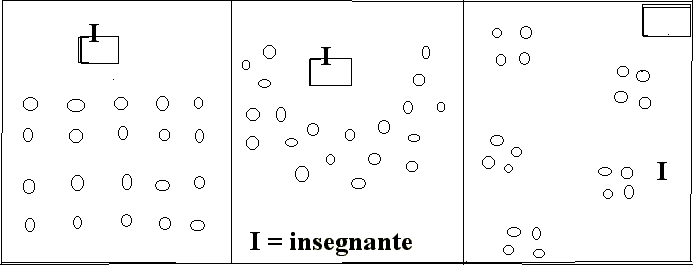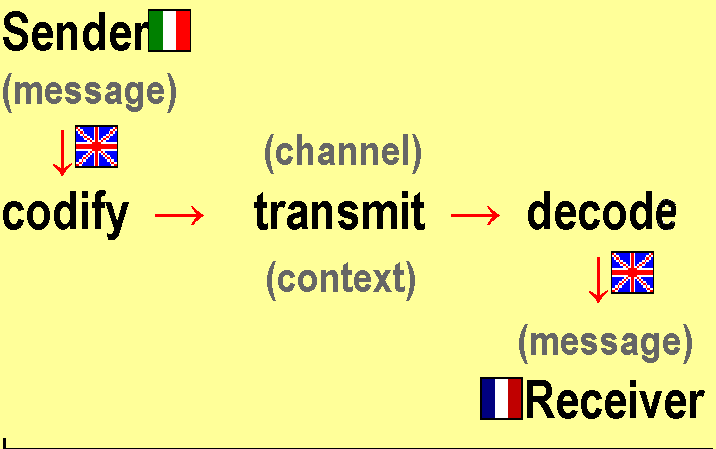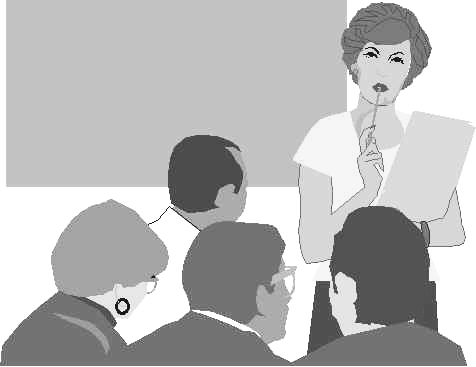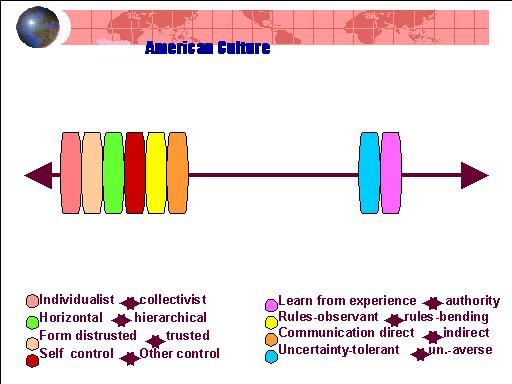
|
|
|
. . |
|
. |
|
Patrick
Boylan patrick @ boylan.it
Questi
lucidi e una bibliografia sul sito www.boylan.it
. |

Fogli di giornale
1. Comunicazione: definizione

-- R. Jakobson, 1982: 350-377 [1958]____

Stabilire
un rapporto*
in cui
cercare un codice comune
|
*contiguità = causa (ipotizzata) dei cambiamenti concomitanti (Watzlawick et al., 1967) |
Esempi:
1.
 2.
2.
Comunicazione interculturale
Lo
stabilire un rapporto (relazionarsi) tra soggetti
con
diverse forma mentis (Weltanschauungen)
Quindi ogni comunicazione è interculturale.
 Lezione
"comunicativa" di francese.
Lezione
"comunicativa" di francese.
|
Materiale: |
Choisir: A.
Quelle heure est-il, s'il vous plaît? |
Il
professore indica studente A (un giovane francese) e poi studente B
("la sua sorella").
Il professore indica a A di fare
domande a B.
1. A:  ?
B:
"8"
?
B:
"8"
2.
2. Linguaggio (e lingua): definizione
un sistema semiotico verbale*
*un insieme aperto di
opposizioni lessico-grammaticali associati con un insieme aperto di
opposizioni semantiche,
avente le proprietà descritte da De
Mauro (1980).
Dato il peso della tradizione (stoici, grammatici alessandrini...), il termine linguaggio tende a significare invece:
un
sistema semiotico verbale scritto
(paragonare l'Etiologia vs. lo studio degli animali imbalsamati)
Ma:
la musica = la scala musicale, le regole di armonia?
la cultura = le istituzioni, le regole di vita di un popolo?
il linguaggio = le parole, le regole di grammatica e d'uso)?
Linguaggio = matrice intenzionale
cioè, la sedimentazione di istanze* di voler dire che esprimono un voler essere ("cultura"). *in eventi comunicativi concreti
 Lezione
sulla L2 come linguaggio.
Lezione
sulla L2 come linguaggio.
Creating Identikits of target culture speakers
(a.)
Creating Commedia dell'arte characters for the C2.
(b.)
'Estrangement activity': be your maschera at home
Creating cultural adaptations of personal scenarios.
Composing pastiches.
Translating by double immersion.
Undergoing initiation within an L2 community
Using different identities on an L2 Internet Dating Service.
Joining an Internet C2 SIG (Special Interest Group)
Playing the L2 speaker in a simulated tandem conversation
Hypothesizing the sense of a cultural tic of an L2 double
Paragonare con:
a. Metodo diretto (grammatica induttiva)
b. Metodo audio-orale (esercizi per riflessi pronti)
c.
Metodo situazionale ("comunicazione")
-
Role play
- Task
3. English (français, italiano...): definizione formale
"A family of idioms with (at least some) formal and (perhaps no) cultural traits in common, derived from Anglo-Saxon and transformed by
- multiple contacts (Normans, Boccaccio, immigrants...),
- lack of contacts (colonies, social classes...) and
- socio-cultural and political divisions (or unifications)
into a dynamic system describable in terms of the norm-providing status of each idiom (Kachru)."
English
is a
family of
sets of intentional matrices*
in a
struggle for hegemony
(*the sedimentation of instances of wills to mean in a particular way that produce classes of ways of being)
Comunicazione
in English (français, italiano...) è dunque la ricerca,
con il proprio interlocutore, di un codice comune, partendo dalla
definizione formale.
Come descrivere l'inglese (il francese, l'italiano) in questo modo?
ADAPTED FROM A. TROMPENAARS, RIDING THE WAVES OF CULTURE, N.Y., 1993
Affectivity<———?———>Neutrality
Specific <———?———> Diffuse
Individualism<——?——>Collectivism-
Meritocracy <——?——> Cooptation--
Universalism<——?——>Particolarism
Distribution
of middle American cultural/communicative traits
(L.
Beamer, http://www.dialogin.com, 2001)
 Lezione
sulle varietà della
L2
in lotta.
Lezione
sulle varietà della
L2
in lotta.
The "context" that gives given semantic content its "meaning" is an experiential whole which must be investigated with experiential (not philological) methods.
Simulated+real-life interaction is necessary to enable learners/researchers to map experimentally the will behind a token, otherwise accessible only through endless philological reconstruction.
Bibliography
Boylan, P. (2001). "Accommodation through a Transformation of Consciousness". Proceedings of the conference Globalisation, foreign languages and intercultural learning, South Bank University, London.
Boylan, P. (2001). "Relativizing the Concept of Communication". In: D. Killick et al. (eds.), Poetics and Praxis of Languages and Intercultural Communication. Glasgow: University of Glasgow Publications, 2001, pp.45-53.
Boylan, P. (2002) Language as representation, as agency, as a new way of being. In S. Cormeraie, D. Killick, M. Parry (eds), Revolutions in Consciousness: Local Identities, Global Concerns in Languages and Intercultural Communication, Leeds: LMU Center for Language Study. pp. 165-174.
De Mauro, T. 1980. Guida all'uso delle parole. Roma: Editori Riuniti.
Gudykunst, W. B. (1991): Bridging Differences: Effective Intergroup Communication. London: Sage.
Halliday, M.A.K. 1975. Learning how to mean: Explorations in the Development of Language. Oxford: Elsevier.
Roman Jakobson, 'Closing Statement: Linguistics and Poetics in T.A. Sebeok (ed.), Style in Language (Cambridge MA, MIT Press, 1982), pp. 350-377. Earlier versions of the same formulation appeared in 1958 and 1960.
Janicki, K. (1986): ‘Accommodation in Native Speaker-Foreigner Interaction’, in J. House, and S. Blum-Kulka (eds.), Interlingual and Intercultural Communication: Discourse and Cognition in Translation and Second Language Acquisition Studies. Tübingen: Gunter Narr Verlag.
Kelly, A.R. & Toshiyuki, K. (1993). "Effects of language intensity similarity on perceptions of credibility, relational attributions, and persuasion". Journal of Language & Social Psychology, 12:3 [Sept.], pp. 224-238.
Thanasoulas, D. (1999) "Accommodation Theory". http://www.tefl.net/articles/accommodation.htm Originally (1999): http://www.geocities.com/CollegePark/Union/7044/dimit15.htm
Trompenaars, F. (1993): Riding the Waves of Culture. London: The Economist Books
Watzlawick P., Beavin J.H. & Jackson D.D. 1967. Pragmatics of human communication. New York: Norton.